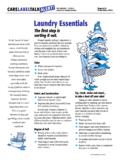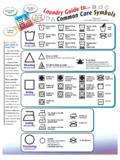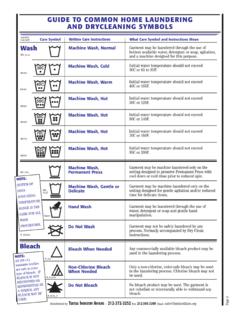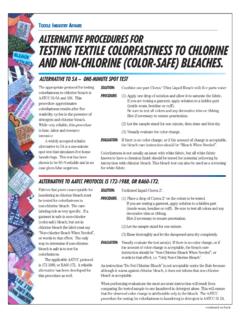Transcription of Building Laundry Skills - Label Talk
1 BuildingLaundrySkills 2005. Textile Industry Affairs. All rights by:Jo Ann Pullen, CFCSF amily and Consumer SciencesTextile Industry Affairs is pleased to sponsor andassist with the development of these materials. You are welcome copy and distribute thesematerials providing they are for educationalpurposes onlyand distributed at no cost to therecipient. Reproducible versions of this and relateddocuments are available on the internet A RETA L KA L ERT !FOR APPA REL / TEXTILE INDUST RYPR OFE S SION A LS & EDUC ATOR SSponsored by Textile Industry AffairsPullenCover3-4-05 3/4/05 5:12 PM Page 1 UNIT: Laundry ESSENTIALS OUTCOME: Knowing and using proper clothing care practices results in positivelife/resource management and money :Students increase life management Skills and save money byproperly caring for my clothing and learning care labelingrequirements for textile willidentify and practice appropriate clothing care practices.
2 (National Standards for Family and Consumer Sciences Education[NSFACSE]: , ) willread and write care labels using words or symbols.( , ) willunderstand textile legislation and labeling in a global economy.(NSFACSE: , )Materials Needed:Bulletin Board:Use sections of the Laundry Essentials brochure,the care symbol chart, and examples of care Supplies: Laundry Essentials BrochureWorksheets: Laundry Essentials Building Laundry Skills Decoding Care Symbols Consumer Guide to Care Symbols ChartTeacher Resources:Textiles and clothing textbooksNational Standards for Family andConsumer Sciences Laundry ESSENTIALS CURRICULUM J. Pullenp.
3 1 of 4 continues on next pageNational Standards for Family and Consumer Sciences decisions about purchasing, creating, and maintaining state and federal policies and laws providing consumer textile legislation, standards, and labeling in the global appropriate procedures for care of textile Concepts:The U. S. requires a permanent care Label on most apparel thatprovides instructions for refurbishing the product and warningsfor any part of the instructions that may have a harmful permanent care Label is one that remains legible and attachedto a textile product throughout its useful nations have established a voluntary or required carelabeling system that uses symbols instead of January 1, 1999, manufacturers and importers may report care instructions on care labels using words in English,ASTM care symbols, or both.
4 Some instructions, such as dryclean may be reported as a symbol and a drycleaningwarning low moisture may be reported in symbols convey care instructions in a simple, space-saving,and easily understood labeling helps consumers select textile products on thebasis of the care method required and reduces loss andcomplaints resulting from inappropriate cleaning labeling is based on five basic refurbishing operations:washing, bleaching, drying, ironing and Activities:1. Laundry Essentials (40-50 minutes)2. Building Laundry Skills (homework)3. Decoding Care Symbols (20-30 minutes) Laundry ESSENTIALS CURRICULUM J. Pullenp. 2 of 4 LESSON 1: Laundry ESSENTIALS (40-50 minutes) ( , ) the assignment on the board:1.
5 Identify appropriate clothing care the learning the students if they buy their ownclothes. After responses, ask the students if they read the labels whenmaking a buying decision. Continue the discussion by asking what theylook for when buying their clothes and how important it is to themwhether the apparel needs to be drycleaned or washed. Tell the studentsthat the purpose of today s learning opportunityis to understand generalprinciples of caring for textile products. out the Laundry Essentials the students that the brochure is a complete guide to caring for clothes that will be laundered. that clothes should be taken to the drycleaner if the wordson the care Label say dryclean there is a circle care symbol present.
6 Besure to point out any stains or spots to the the studentsthat the Textile Industry Affairs Division of the Clorox Company, decided to provide this laundering brochure to studentsat no cost to the school. Tell the students that the informational content of the brochure contains no advertising. The brochure does provide thename and identifier of the company that produced it in case they wantmore information. The brochure is comprehensive including pretreating, washing, bleaching, drying, ironing, stain removal, and care symbol information. (Note: you may order enough brochures to give one to eachof your students.) the students have completed their work, ask the students ifthey do their Laundry .
7 Which steps in clothes care are new to them? Do they care for their clothes in different ways than recommended in thebrochure? What are the benefits of each method? the students the homework assignment, Building LaundrySkills. Explain that they need to help with the Laundry and then have aparent/guardian sign that they completed the assignment. Point out thatall the steps need not be done. If they don t iron clothes, simply write thatdown. Set a due date and have them write it down on the quality completion of worksheet and homework. Laundry ESSENTIALS CURRICULUM J. Pullenp. 3 of 4 LESSON 2: DECODING CARE SYMBOLS (20-30 minutes) ( , ) the assignment on the board:Skill in Decoding Care Symbols prepares you to be a global each student a care Label that includes the studentswhich of the care symbols seems easy to decode.
8 Have students predict someinstructions for various care symbols. If you do not have care labels available,draw some care symbols on the board: machine wash, permanent press, warm;only non-chlorine bleach when needed; tumble dry, low; iron, the students to use the Laundry Essentials and the ASTM Consumer Guide to Care Symbols to decode and encode the care instructionson the worksheet. Explain that they are to look for patterns in the symbol system as they do their done, explain that they willpractice the intelligent behavior of search-ing for patterns. Tell them that complex systems usually have simple patternswithin the system. To understand this system, ask the students to examine thechart to locate any patterns.
9 Review each process beginning with washing. Whatis the basic symbol? How are the permanent press and gentle cycle represented?Are the single-bar and double-bar symbols used anywhere else on the chart?Compare the temperature symbols through the washing, drying, and ironingprocesses. Continue asking the students to identify patterns in the symbol sys-tem. Have them summarize those found: (1) temperature/heat settings: hot/high three dots, warm/medium two dots, cold/low - one dot; (2) cycle settings:normal cycle - no bar, permanent press cycle - one bar, gentle or delicate cycle two bars; (3) warning: X do not; (4) a milder process: add two diagonal barsfor non-chlorine bleach or shade dry; and, (5) the order of the symbols followconsumer practice: washing, bleaching, drying, ironing, and may test their comprehensionwith a quick review quiz:a.
10 Name the care instruction that is represented by the washtub, the triangle, the square, the iron, and the circle. b. What symbol represents hot, warm, cold, very hot, normal action, permanent press action, gentle action, and do not? c. What symbol represents only non-chlorine bleach when needed? by pointing out thatU. S. apparel and textile manufacturers andimporters are required to provide certain information to consumers. Thisrequired information helps consumers select textiles on the basis of fiber content,care requirements (apparel only), country of manufacture and the name of themanufacturer. Voluntary information can include the brand name, a trademark,the fabric construction, a fabric finish, the size of the item, and any guarantees.




